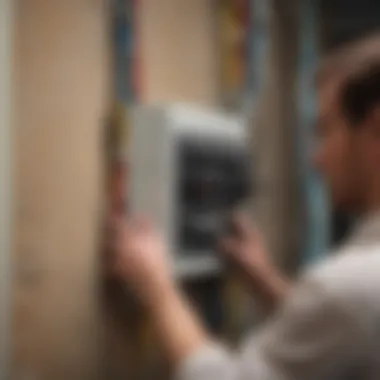Comprehensive Guide to Fixing a Tripped Circuit Breaker


Intro
A tripped circuit breaker is often an unexpected but frequent annoyance for many homeowners. Understanding the significance of a functioning electrical system is crucial, not just for day-to-day convenience but also for ensuring safety and efficiency within the home.
When a circuit breaker trips, it can disrupt the electrical flow and potentially expose the home to hazards if not addressed properly. This guide aims to provide a thorough understanding of the causes of circuit breaker issues, effective troubleshooting strategies, and essential safety measures. Homeowners and design enthusiasts will find this information valuable, allowing them to engage more deeply with their electrical systems.
Understanding why a circuit breaker might trip is key. There are various reasons that can lead to this occurrence. These can range from simple overloads to more serious wiring issues. Each cause has specific troubleshooting steps that can help isolate the problem, making it easier to rectify. This guide does not just address immediate fixes; it promotes a broader understanding of electrical infrastructure, leading to better home safety practices and efficiency improvements.
In the following sections, readers will explore the systematic approach to diagnosing and fixing tripped circuit breakers. This will empower them to take informed actions when faced with this common issue.
Understanding Circuit Breakers
Understanding circuit breakers is crucial as they are key components in any electrical system in a home or commercial setup. They protect electrical circuits from overload or fault conditions that could lead to hazardous situations like fires or equipment damage. Their functionality is vital for ensuring safety and maintaining the integrity of electrical systems.
When circuit breakers work correctly, they provide a safe pathway for electricity. They stop excessive current flow which could otherwise cause wiring or devices to overheat. Recognizing how circuit breakers operate, what types exist, and their structural components equips homeowners and enthusiasts with the knowledge to confront issues effectively. This understanding not only supports better home safety but also can improve overall system efficiency.
Definition and Purpose
A circuit breaker is an electromechanical switch designed to protect electrical circuits. Its primary purpose is to interrupt current flow in the event of an overload or a short circuit. Unlike a fuse which needs replacement after it blows, a circuit breaker can be reset after it trips. This feature makes it more convenient and efficient for managing electrical flow in a home.
The importance of circuit breakers cannot be overstated, as they function as the first line of defense in electrical safety, preventing potential electrical hazards.
Types of Circuit Breakers
Circuit breakers come in several types, each serving specific functions and offering unique advantages. Understanding these types is essential for selecting the right option for your needs.
Standard Circuit Breakers
Standard circuit breakers are the most common type. They function to protect residential circuits by tripping in response to an overload or a fault. One key characteristic of standard breakers is that they are available in various amperages. This allows them to be tailored to the specific needs of different circuits.
These breakers are beneficial because they provide a straightforward and effective way to manage electricity. Their unique feature is the thermal-magnetic mechanism, which detects overheating through heat generated and excessive current through magnetism. While they are reliable, one disadvantage is that they may not offer specific fault detection, unlike more advanced breakers.
GFCI Breakers
Ground Fault Circuit Interrupter (GFCI) breakers are designed to prevent electrical shock by detecting discrepancies between outgoing and incoming current flow. They are especially useful in areas with high moisture, such as kitchens and bathrooms. The key characteristic of GFCI breakers is their ability to trip within milliseconds of detecting a ground fault, which is vital for preventing accidents.
GFCI breakers are considered essential for safety in wet areas. Their unique feature is the rapid response time, which greatly enhances user safety. However, they can be sensitive and may trip even with minor fluctuations, serving as a potential disadvantage in their practicality.
AFCI Breakers
Arc Fault Circuit Interrupters (AFCI) breakers are designed to prevent electrical fires caused by arcing faults. The primary focus of AFCI breakers is on fire prevention, making them more advanced than standard breakers. The key characteristic of AFCI breakers is their ability to distinguish between normal operation and potentially dangerous arcs.
This ability makes them valuable for enhancing safety standards in a home. Their unique feature includes the capability to detect both series and parallel arcs. One drawback, however, is their cost, which may be higher than standard circuit breakers. This can be a consideration when upgrading electrical systems.
Components of a Circuit Breaker
Understanding the components of a circuit breaker helps demystify its operation. A typical circuit breaker has three main components: the switch, the bimetallic strip, and the electromagnet. The switch allows manual control over the circuit. The bimetallic strip changes shape in response to heat, causing the breaker to trip during overloads. Finally, the electromagnet acts swiftly to trip the breaker in case of a short circuit.
Overall, a thorough grasp of circuit breakers not only arms homeowners with knowledge to troubleshoot issues but also helps foster an awareness of electrical systems' safety and efficiency.
Common Reasons for a Tripped Circuit Breaker
Understanding the common reasons a circuit breaker trips is crucial for effective troubleshooting and ensuring the safety of your home. A tripped circuit breaker can lead to interruptions in electrical service, suggesting underlying issues that need addressing. By diagnosing the cause accurately, homeowners can avoid potential hazards and make informed decisions about repairs or upgrades. This section delves into the primary factors contributing to circuit breaker trips, equipping readers with the knowledge necessary to maintain an efficient electrical system.
Overload of Electrical Circuits
One of the primary reasons for a tripped circuit breaker is the overload of electrical circuits. This occurs when too many devices draw power from a single circuit, exceeding its capacity. Each circuit in a home has a designated amperage limit, typically 15 or 20 amps.


- How it Happens: If several high-power appliances, like a refrigerator, air conditioner, and microwave, operate simultaneously on the same circuit, this can lead to overheating and a trip.
- Signs to Watch For: Frequent breaker trips or a warm breaker may indicate overload.
- Solution: Distributing devices across multiple circuits can help. Installing dedicated circuits for high-use appliances is beneficial.
Short Circuits
A short circuit is another critical cause of tripped circuit breakers. This situation happens when a live wire comes into contact with the neutral wire or a grounded surface, creating a low-resistance path for electrical current.
- Common Causes: Damaged cords, faulty appliances, or debris can lead to short circuits.
- Identifying Short Circuits: An unusual smell or sparks near outlets and sudden breaker trips can be signs.
- Corrective Actions: Checking wiring and ensuring appliances are in good condition is essential. If the issues persist, consulting a professional is advised.
Ground Fault Issues
Ground fault issues arise when a live wire touches a grounded surface or another wire. This is more likely in wet areas, such as kitchens or bathrooms, where moisture increases electrical conductivity.
- Typical Scenarios: Using appliances near water or having faulty wiring increases risks. Ground Fault Circuit Interrupters (GFCIs) are designed to detect and prevent such scenarios.
- Recognizing Ground Faults: Restless circuit breaker trips when using specific devices can indicate a ground fault.
- Prevention: Installing GFCI breakers or outlets in moisture-prone areas helps mitigate risks.
Faulty Circuit Breaker
Sometimes, the breaker itself is to blame for the tripping. Aging equipment or manufacturing defects can cause sporadic tripping without any visible cause.
- Symptoms of Malfunction: Unusual sounds or a breaker that will not reset may indicate that it is faulty.
- When to Replace: If a breaker trips frequently despite no loads exceeding its limits, it might be time to consider a replacement.
- Recommendation: Regular inspection of circuit breakers can ensure reliable performance. If a malfunction is suspected, seek a qualified electrician for evaluation.
Key Insight: Identifying the reason behind a tripped circuit breaker can save both time and money, preventing future disruptions and ensuring a safe living environment.
Initial Safety Precautions
Before delving into troubleshooting electrical issues, taking initial safety precautions is crucial. This section illuminates the steps that help safeguard individuals from potential electrical hazards. Proper safety measures ensure a systematic approach, minimizing risk and enhancing the overall effectiveness of any electrical work. Having a clear guide allows individuals to engage confidently in resolving circuit breaker trips.
Assessing the Environment
Assessing the environment where electrical work is to take place is a necessary step. Before beginning troubleshooting, examine the area to spot any obstructions or potential hazards. Ensure the work zone is dry and clear of moisture, which could lead to electrical shock. Remove any unnecessary items or debris which might hinder movement.
Next, identify the appliance or circuit involved. Isolate the larger equipment to reduce distractions. Understanding the specific layout of your electrical system can prevent accidents. Having adequate lighting also helps in detailed inspections. Recognizing environmental factors sets a foundation for safe practices during the troubleshooting process.
Wearing Protective Gear
Wearing proper protective gear is fundamental to ensuring safety during electrical work. Basic equipment includes insulated gloves, safety goggles, and non-slip shoes.
- Insulated Gloves: These are designed to protect against electric shock. They form a barrier between your skin and any live wires or components.
- Safety Goggles: Protect your eyes from sparks, splashes, and debris during repairs.
- Non-slip Shoes: Prevent slipping and provide steady footing, especially in potentially hazardous areas.
Always inspect protective gear before use. Any wear or tear can compromise effectiveness. Investing in good quality safety equipment is essential; it may seem trivial, but these measures could potentially save lives.
Ensuring Power Isolation
Ensuring power isolation is a critical precaution before performing any electrical work. This involves turning off the power supply to the specific circuit where you are working. Locate the circuit breaker panel and switch off the appropriate breaker. It’s advisable to use a multimeter to confirm that the circuit is inactive before proceeding with inspections or repairs.
- Label Circuits: If not already labeled, take this opportunity to note what each circuit controls. This can help avoid confusion in future work.
- Use Lockout/Tagout Procedures: For longer tasks, placing a lock on the breaker box with a tag indicating work is ongoing can prevent accidental reconnection of power.
By ensuring power is completely isolated, you mitigate risks of electric shocks and enhance safety dramatically during troubleshooting.
Always prioritize safety when working with electricity. Small oversights can lead to severe consequences.
Step-by-Step Troubleshooting Process
Understanding the step-by-step troubleshooting process is key in addressing a tripped circuit breaker effectively. This process enables homeowners to systematically identify and resolve issues, minimizing potential risks to electrical systems. It is vital to follow these steps carefully to ensure safety and efficiency. A logical approach helps prevent misunderstandings and unnecessary complications. Moreover, each step builds upon the previous one, ensuring no crucial aspect is overlooked.
Identifying the Problem Circuit
The first step in troubleshooting is identifying the specific circuit that has tripped. This involves checking the circuit panel for which breaker has switched to the off position. Take note of both the affected breaker and the appliances or outlets that it controls. This identification aids in narrowing down the possible cause of the issue. Consider this information:


- Label Your Breakers: If your circuit breakers are not already labeled, do so for future reference. Knowing which breakers control which areas or appliances will save time when troubleshooting.
- Monitor for Patterns: If a particular circuit trips often, document when and why it occurs. Patterns may suggest a recurring issue or a specific appliance causing problems.
Inspecting Connected Appliances
Appliances connected to the problematic circuit should be inspected next. Disconnect all devices plugged into the outlet circuit in question. Look for signs of damage, such as frayed cords or burnt plugs. These factors can easily lead to a tripped breaker due to overload or short circuits. Consider checking:
- Appliances in Use: Identify if high-wattage devices were in use when the breaker tripped. For example, using a heater or air conditioning unit simultaneously with other power-hungry appliances can lead to overload.
- Faulty Equipment: If you suspect a certain appliance, test it in another circuit. If it trips another breaker, the appliance is likely faulty.
Resetting the Circuit Breaker
Once the problem appliance is isolated, the next step is resetting the circuit breaker. To do this:
- Switch Off the Breaker: Firmly push the tripped breaker to the off position. This ensures that the breaker is reset correctly.
- Return to ON Position: After a moment, switch it back to the ON position. Listen for a click, indicating that it has reset properly.
- Monitor Behavior: After resetting, watch for any immediate issues. If it trips again quickly, do not repeatedly reset the breaker. This can indicate a significant issue requiring further investigation.
Testing Circuits Post-Reset
After resetting the circuit breaker, it's time to test the circuit to ensure it is functioning properly. Plug in only one appliance at a time and turn it on. This method allows you to determine if a specific appliance causes the trip. Performance checks involve:
- Gradual testing: Start with smaller devices, such as lamps, before moving to larger appliances. This step increases safety and reduces unnecessary load on the circuit.
- Check for Immediate Trips: If the breaker trips again, it indicates a deeper issue than just overload; further analysis may be needed. In such cases, document what appliance was in use at the time.
"Always prioritize safety when dealing with electrical systems. If unsure, consult with a professional."
Following this structured approach enables a clearer understanding of electrical issues related to circuit breakers. It fosters a proactive attitude in tackling similar problems in the future.
When to Seek Professional Help
When dealing with a tripped circuit breaker, it can be tempting to resolve the issue independently, especially if you have followed the basic troubleshooting steps. However, there are instances where engaging a professional is not just advisable, but essential for safety and reliability of the electrical system.
Persisting Issues
If the circuit breaker continues to trip after several attempts to reset it, this indicates a deeper problem exists. Repeated tripping can suggest a persistent overload or an underlying wiring issue that requires diagnostic expertise.
Ignoring this situation can lead to significant hazards such as electrical fires or damage to connected appliances. An experienced electrician can inspect your home’s wiring, identifying potential short circuits or grounding issues, ultimately providing solutions tailored to your specific scenario. Searching for a licensed professional can greatly ease this process and ensure compliance with safety standards.
Signs of Hardware Failure
Hardware failure may not always be immediately evident to a homeowner. However, certain indicators suggest you should call a professional. Unusual smells, such as burnt plastic or a device that feels hot to the touch can be ominous signs.
Additionally, any physical damage on the circuit breaker panel or the breaker itself should never be ignored. This includes corrosion or blown fuses.
"A malfunctioning breaker can compromise your entire electrical system, making it critical to prioritize assessment by qualified personnel."
A qualified electrician will have the tools and knowledge to properly diagnose and replace faulty equipment, preventing further damage to your home’s electrical infrastructure.
Complex Electrical Problems
Some electrical issues can be intricate, involving multiple circuits or specialized systems. For instance, if rewiring or integration of new appliances is needed, it is essential to involve an expert. They can navigate local electrical codes, ensuring that installations meet safety regulations.
Beyond installations, troubleshooting complex circuitry or addressing systemic issues requires specialized understanding of electrical systems, often beyond general homeowner knowledge.
Preventive Measures to Avoid Tripping
Preventive measures play a crucial role in ensuring the smooth operation of your electrical systems. By adopting certain practices, homeowners can significantly reduce the likelihood of a circuit breaker trip. This section outlines specific elements and benefits involved in maintaining electrical safety and efficiency.
Regular Inspection and Maintenance
Regular inspection and maintenance of your electrical system are fundamental. This includes periodic checks on circuit breakers, wiring, and electrical outlets. Homeowners should examine for signs of wear or damage, such as frayed wires or scorch marks on outlets. Conducting inspections can often prevent small issues from escalating into larger problems that may lead to breaker trips.


- Schedule professional checks at least once a year.
- After storms, inspect outdoor connections for damages.
- Make a note of any peculiar sounds or smells coming from electrical systems.
Proper maintenance of appliances is also important. Regular cleaning, checking cords for issues, and ensuring they are in good working order can prevent overloading circuits. Regular maintenance helps in identifying potential faults before they cause a tripped breaker.
Upgrading Electrical Systems
As technology evolves, so too should your electrical systems. Upgrading outdated wiring and circuit breakers can improve safety and compliance with modern standards. Old wiring can become a fire hazard if not replaced, as it may not handle current loads.
Consider these upgrades:
- Replace circuit breakers with more sensitive options like GFCI and AFCI for added protection.
- Install additional circuits to distribute loads more effectively.
- Upgrade to energy-efficient appliances which use less power, reducing the risk of overloads.
Understanding local regulations regarding electrical upgrades is vital. These regulations help ensure work meets safety standards and minimizes risks of tripping breakers in the future.
Proper Appliance Usage
Using electrical appliances thoughtfully can significantly reduce the risk of circuit trips. Homeowners should be aware of the total load on a circuit and avoid plugging too many devices into one outlet. Ensuring that appliances are not exceeding their rated capacity is important for safety.
Key practices include:
- Educate family members about proper appliance usage and the limits of electricity.
- Avoid using multiple high-wattage appliances on the same circuit at peak times.
- Unplug devices that are not in use, as they can still draw power.
By incorporating these preventive measures, homeowners can foster a safer and more efficient electrical environment. This promotes not only the longevity of electrical systems but also enhances overall home safety.
Understanding Electrical Codes
Understanding electrical codes is crucial for anyone involved in home electrical systems. These codes are designed to ensure safety, efficiency, and consistency in electrical installations. They encompass a range of regulations established by organizations such as the National Fire Protection Association and the International Electrotechnical Commission. Ignoring these codes can lead to dangerous situations and malfunctions, potentially increasing the risk of electrical fires or shock.
Importance of Compliance
Compliance with electrical codes is not just a recommendation; it's a necessity for safety. Any electrical work carried out without adhering to these codes can result in substandard installations. This can pose risks to the lives of residents and damage property. Moreover, many insurance companies require proof of code compliance before issuing policies. Therefore, understanding these regulations can also protect homeowners from potential liabilities.
When homeowners undertake DIY projects, they must ensure that their installations meet current codes. This includes understanding load calculations, following installation guidelines, and using approved materials. Failure to comply can lead to faulty wiring or overloaded circuits, which might trip circuit breakers frequently.
"Electrical codes exist to safeguard both lives and property by providing guidelines that dictate how electrical systems should be designed and maintained."
Local Regulations and Standards
Local regulations can vary significantly from one area to another. While national standards provide a framework, local codes may impose additional requirements based on regional characteristics. It is essential for homeowners to familiarize themselves with these local regulations when tackling electrical issues.
Local codes can address specific conditions such as:
- Climate factors, which may influence wiring insulation needs.
- Historical preservation mandates, which can dictate the types of materials used in renovations.
- Specific safety measures for high-density housing developments.
Homeowners must check local municipalities for zoning laws and building codes. Building departments or local fire marshals usually have resources available for residents. When hiring professionals, ensure they are aware of local codes to avoid future complications and enhance safety.
Awareness and compliance with local electrical codes not only ensure safety but also facilitate smoother inspections when upgrading or renovating a property. Coordinating with local regulations can save time and expense in the long run.
Finale
In the context of this article, the conclusion serves as a critical reinforcement of the ideas discussed throughout the guide. Understanding how to address a tripped circuit breaker not only resolves immediate electrical interruptions but also contributes to the overall safety and efficiency of a home’s electrical system. Awareness of electrical problems, their causes, and effective troubleshooting methods equips homeowners with the necessary knowledge to maintain their systems safely.
Moreover, it emphasizes the significance of adhering to safety practices and complying with local electrical codes. Such elements are vital not only for personal safety but also for the longevity of the electrical infrastructure within a home. By integrating these considerations, homeowners can prevent future issues, ensuring a more reliable and effective electrical system. In sum, the culmination of this guide reframes the narrative around electrical maintenance from a mere inconvenience to a proactive responsibility.
Summary of Key Points
- A tripped circuit breaker indicates potential electrical issues that warrant investigation.
- Common causes include overloads, short circuits, and ground faults.
- Initial safety precautions are crucial to prevent injuries during troubleshooting.
- Systematic troubleshooting involves identifying the problem circuit, inspecting appliances, and testing circuits.
- Seeking professional help is advisable for persistent issues or complex problems.
- Regular inspection, code compliance, and careful appliance use can prevent trip occurrences.
Final Thoughts on Electrical Safety
Electrical safety is paramount for any household. Understanding the mechanics of circuit breakers and the implications of their failure encourages vigilant oversight of electrical systems. It ensures that any issues are tackled promptly, minimizing risks associated with electrical fires or electrical shocks. Given the potential consequences of ignoring electrical malfunctions, every homeowner should prioritize this knowledge not just as an optional skill, but as a critical component of home management.
Being informed leads to a safer environment for both residents and guests. In the end, proactive measures and adherence to safety precautions create an electrical infrastructure that is not only functional but also secure.



